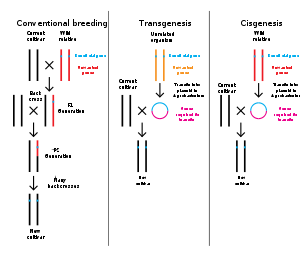- Transgenesis
-
Transgenesis is the process of introducing an exogenous gene – called a transgene – into a living organism so that the organism will exhibit a new property and transmit that property to its offspring. Transgenesis can be facilitated by liposomes, plasmid vectors, viral vectors, pronuclear injection, protoplast fusion, and ballistic DNA injection.
Transgenic organisms are able to express foreign genes because the genetic code is similar for all organisms. This means that a specific DNA sequence will code for the same protein in all organisms.
Using plasmids from bacteria
The plasmid DNA is cut using restriction enzymes, while the DNA to be copied is also cut with the same restriction enzyme, producing sticky-ends. This allows the foreign DNA to hybridise with the plasmid DNA and be sealed by DNA ligase enzyme.
See also
Genetic engineering Genetically
modified
organismsMammalsMaizePotatoAmfloraRiceSoybeanRoundup Ready soybean · Vistive GoldTomatoFish tomato · Flavr SavrCottonBt cotton · Roundup Ready cottonOtherFishGlofish · SalmonBacteria and virusesProcesses TypesUses In agricultureIn humans and diagnosticsGene therapy · Genetic enhancementIn researchRelated articles Transgene · Detection of genetically modified organisms · Genetic pollution · Genetic engineering in fiction · Reverse transfectionSimilar fields Categories:- Genetics stubs
- Genetic engineering
Wikimedia Foundation. 2010.

